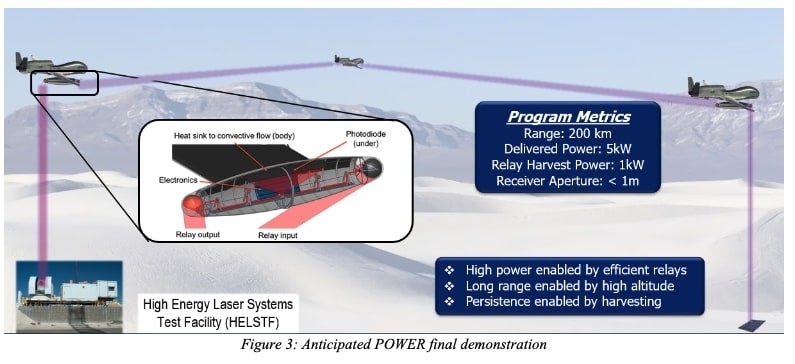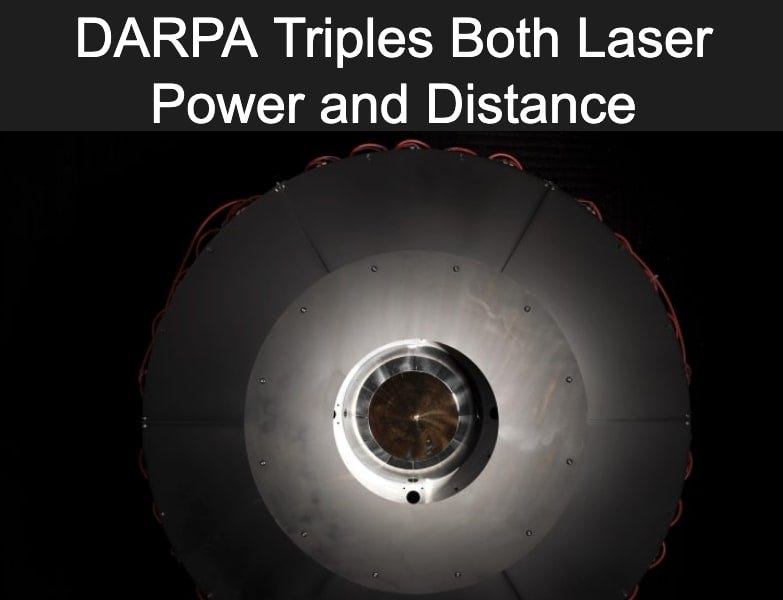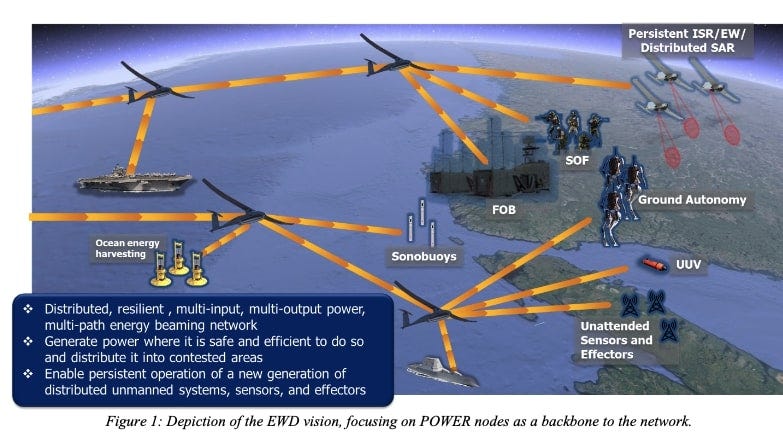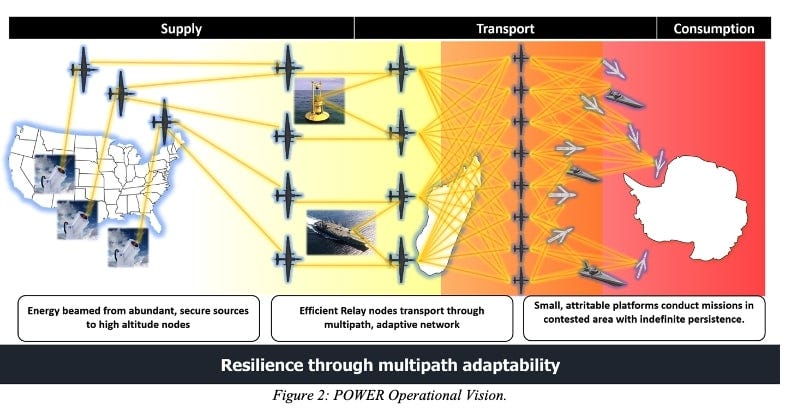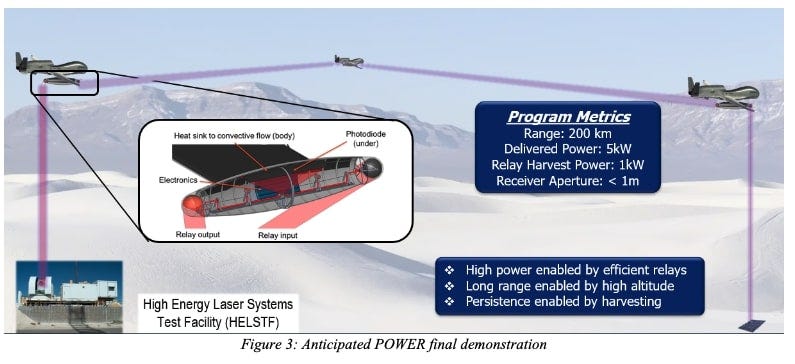DARPA Progress to 2028 Goal of 120 Mile Drone Energy Web With Laser Power Beaming
by Brian Wang
The DARPA Persistent Optical Wireless Energy Relay (POWER) program achieved several new records for transmitting power over distance. The team recorded more than 800 watts of power delivered during a 30-second transmission from a laser 8.6 kilometers (5.3 miles) away. Over the course of the test campaign, more than a megajoule of energy was transferred. The DARPA goal is to beam power over battlefield distances of 120 miles at 5 kilowatts of power using a network of drones. New records have been set by the program and the underlying technology is described and the long-term vision for a wireless energy network. The content is drawn from DARPA announcements and includes illustrative diagrams and charts.
Breakthrough Records in Power Transmission
The POWER program has set new benchmarks in optical power beaming, demonstrating the ability to transmit significant energy over long distances wirelessly. In a recent test campaign, a DARPA-led team transmitted over 800 watts of power from a laser source 8.6 kilometers (5.3 miles) away to a receiver during a 30-second interval.
Over the entire campaign, more than one megajoule of energy was successfully transferred.This surpasses previous records for transmitting appreciable optical power (defined as greater than 1 microwatt). Prior achievements included:
230 watts of average power over 1.7 kilometers for 25 seconds.
An undisclosed but lesser amount over 3.7 kilometers.
In comparison, DARPA's test achieved approximately 3.5 times the power (800 watts vs. 230 watts) and about 5 times the distance (8.6 km vs. 1.7 km).The tests involved collaboration between industry, government entities, the U.S. Naval Research Laboratory, and the High Energy Laser Systems Test Facility (HELSTF) at the U.S. Army's White Sands Missile Range in New Mexico.An accompanying chart (from the first image) visualizes these records on a bar graph:
X-axis: Distance in meters (ranging from 325 m to 8,600 m).
Y-axis: Power in watts (up to 800 W).
Bars show historical milestones, including:
325 W at 325 m (Power Transmitted Over Laser, 2019) in blue.
230 W at 1,700 m (Safe, Continuous Power Beaming - Optical, 2021) in green.
500 W at 1,700 m (Lockheed Martin Battery Charging, 2024) in purple.
800 W at 8,600 m (POWER Receiver Array Demo, 2025) in yellow, dominating the graph.
This progress aligns with the program's goal of enabling instant power delivery from generation sites (where energy is abundant and easy to produce) to remote locations, freeing platforms like drones from fuel constraints and opening new design possibilities.
Receiver Technology and Efficiency
The demonstration utilized a novel receiver design under the Persistent Relay Array Demonstration (PRAD). Key features include:
A compact aperture that captures the incoming laser beam with minimal light escape.
Inside the receiver: The beam strikes a parabolic mirror, which reflects it onto dozens of photovoltaic cells (similar to solar cells) to convert optical energy back into electrical power.
Efficiency measurements showed over 20% conversion from laser output to receiver electrical output at shorter distances. The focus was on quickly validating long-distance potential, so some efficiency trade-offs were made to expedite development—the receiver was designed and built in just three months.
Powering Drones and Building a Wireless Energy Web
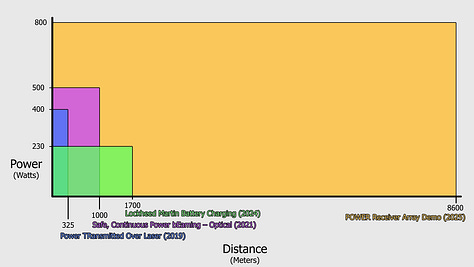
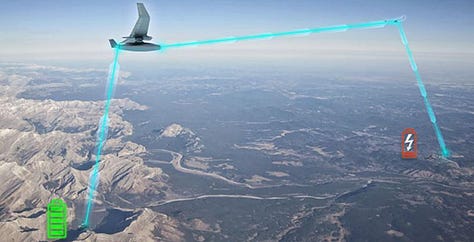
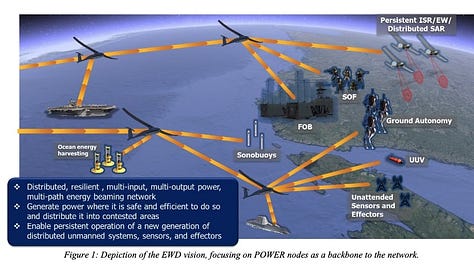
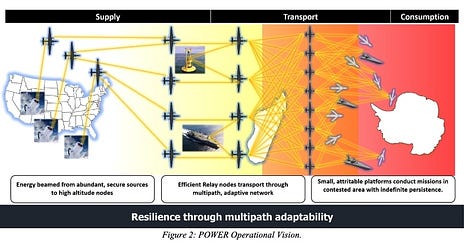

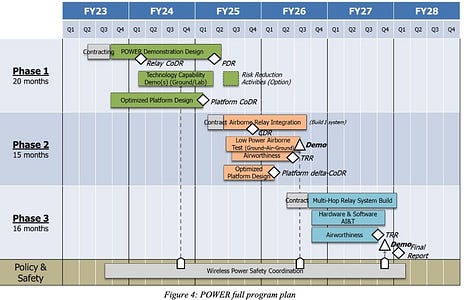
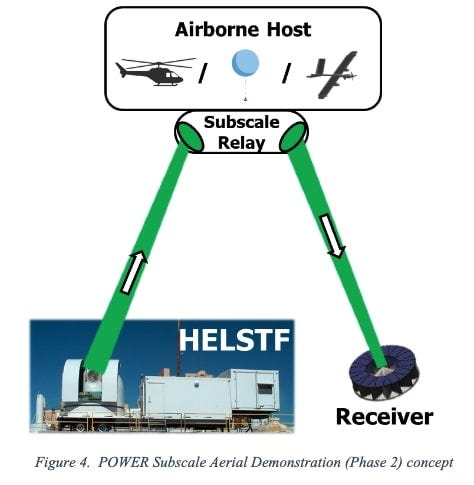
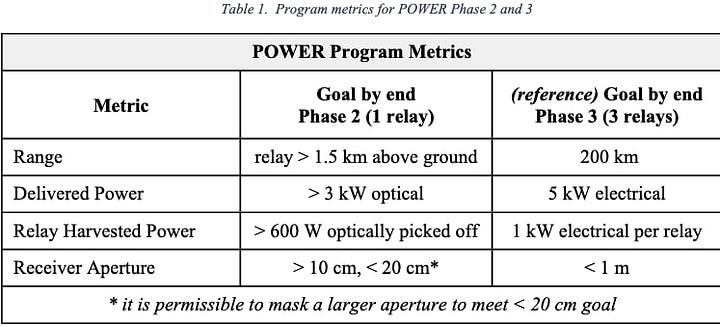
The article shifts to the program's applications, particularly for drones and creating a "power web" for on-demand energy delivery.
Phase 2 Developments: Contracts for Phase 2 are expected to be awarded in mid-to-late 2025. This six-month effort will develop an integrated subscale relay system.
Culminating Demonstration: Planned for 2026 at HELSTF in New Mexico. It will use an existing HELSTF laser as the ground source to transmit power through an airborne relay to a ground receiver, validating ground-to-air-to-ground transmission.
A conceptual image depicts this: A drone-like airborne relay at high altitude receives a green laser beam from a ground battery icon (source) and redirects a blue beam downward to a lightning bolt icon (receiver) over mountainous terrain, illustrating energy relay over distance.DARPA's vision is a distributed wireless energy web supporting persistent operations. Another diagram (third image) shows a network over a coastal/oceanic area:
Power beams (orange lines) connect nodes like ocean energy harvesting, sonobuoys, forward operating bases (FOB), special operations forces (SOF), unmanned underwater vehicles (UUV), ground autonomy, and unattended sensors/effectors.
Caption: A resilient, multi-input/multi-output power beaming network that generates power safely and distributes it to contested areas, enabling a new generation of distributed unmanned systems, sensors, and effectors.
A global operational vision diagram divides into three sections:
Supply: Energy beamed from abundant U.S.-based sources to high-altitude nodes.
Transport: Efficient relay nodes transport power through a multipath, adaptive network (e.g., to ships or platforms).
Consumption: Small, attritable platforms conduct missions in contested areas with indefinite persistence (e.g., over Antarctica-like regions).
Theme: Resilience through multipath adaptability.
The long-term potential includes unlimited range and endurance for drones via wireless power from airborne relays.
Keep reading with a 7-day free trial
Subscribe to next BIG future to keep reading this post and get 7 days of free access to the full post archives.


